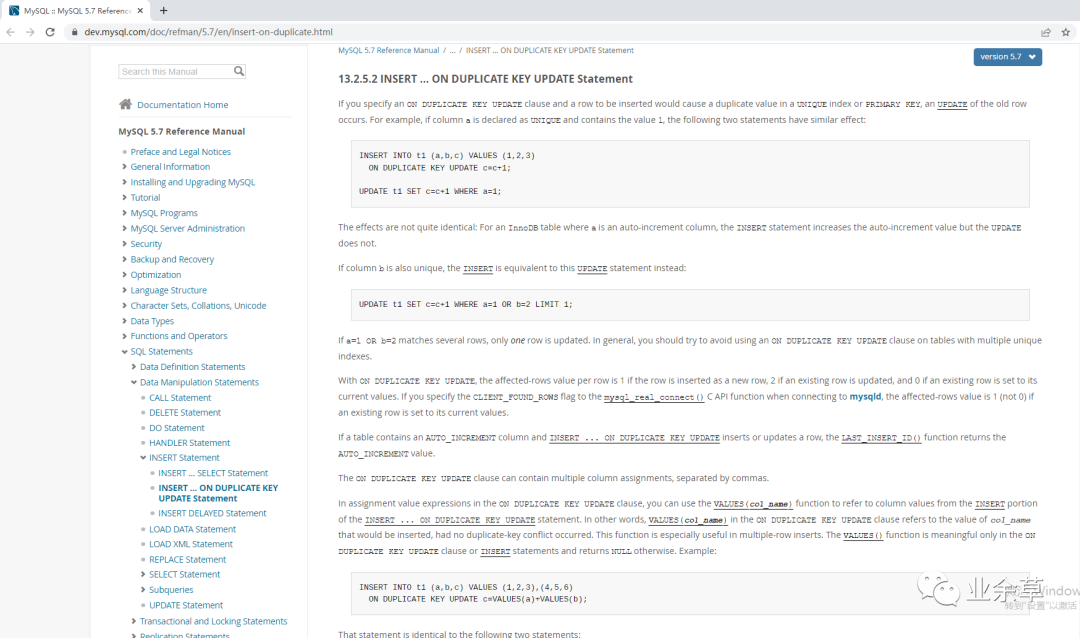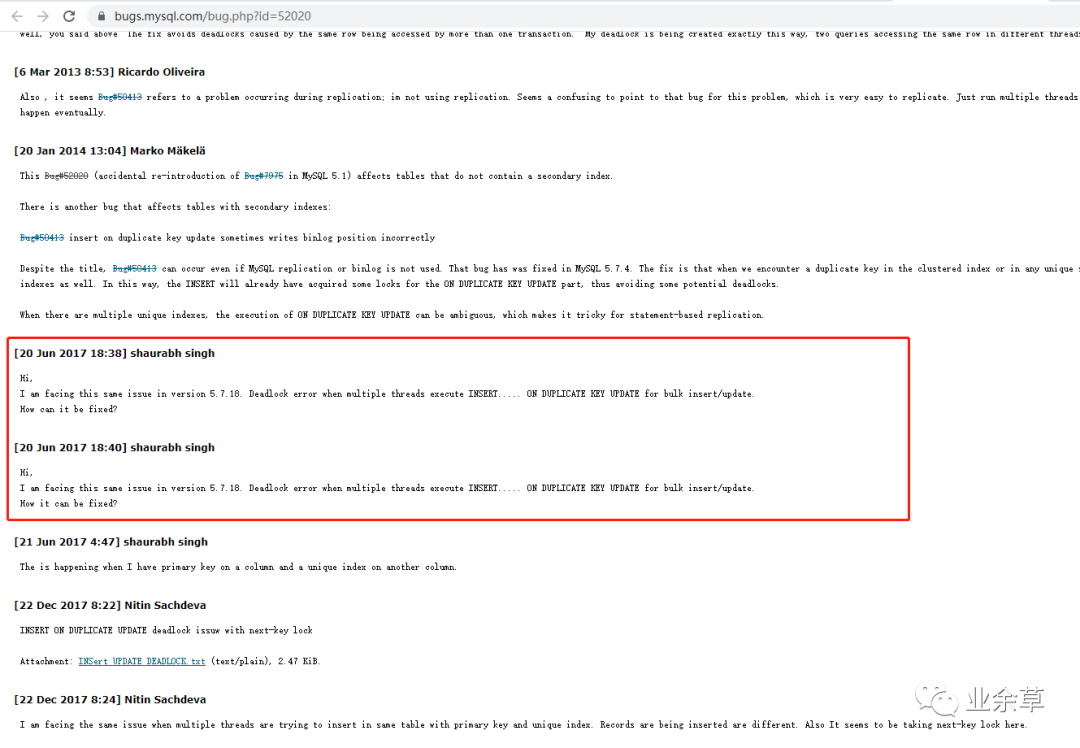为什么不建议使用ON DUPLICATE KEY UPDATE?
你知道的越多,不知道的就越多,业余的像一棵小草!
你来,我们一起精进!你不来,我和你的竞争对手一起精进!
编辑:业余草
puhaiyang.blog.csdn.net
推荐:https://www.xttblog.com/?p=5349
昨天评审代码时,一群大佬看到有同事的代码里使用了mysql的on duplicate key update语法实现了对数据的save or update,说这个语法有严重的性能和其他隐患问题,必须改成先查询一次分出新增集合和修改集合,再分别进行批量新增和批量修改的方式进行,并对批量修改时使用case when的方式实现。
对于批量修改,在mybatis中也就是类似这种的xml:
<update id="updateByIds">
update tb_user
<trim prefix="set" suffixOverrides=",">
<trim prefix="name = case" suffix="end,">
<foreach collection="list" item="i" index="index">
when id= #{i.id,jdbcType=VARCHAR} then #{i.name,jdbcType=VARCHAR}
</foreach>
</trim>
<trim prefix="weight = case" suffix="end,">
<foreach collection="list" item="i" index="index">
when id= #{i.id,jdbcType=VARCHAR} then #{i.weight,jdbcType=DECIMAL}
</foreach>
</trim>
<trim prefix="high = case" suffix="end,">
<foreach collection="list" item="i" index="index">
when id= #{i.id,jdbcType=VARCHAR} then #{i.high,jdbcType=DECIMAL}
</foreach>
</trim>
</trim>
where id in
<foreach collection="list" item="item" open="(" close=")" separator=",">
#{item.id,jdbcType=VARCHAR}
</foreach>
</update>
公司同事写的批量修改 SQL。对于这种做法我也表示认同,但同事追问了一句,很想了解一下on duplicate key update到底有什么问题,很多同事也说不出具体的性能和隐患原因在哪里,所以我就写出了这篇文章。
官方资料
为了能更直接获取出最权威的信息,直接上mysql的官方说明查看有无对应的资料。根据使用的mysql版本查看对应的说明,如我这里的mysql5.7为例,其官方说明地址如下:
https://dev.mysql.com/doc/refman/5.7/en/insert-on-duplicate.html。
其中对于「on duplicate key update」的使用方法也有非常详细的说明。

这里对于它的使用方法不做介绍,感兴趣的可以点开上面的链接进行详细的查看。
但为了对官方文档中的说明进行验证,这里根据官方的说明进行一个小实验进行验证。
创建一个t1表:
CREATE TABLE `t1` (
`a` bigint(20) unsigned NOT NULL AUTO_INCREMENT COMMENT '自增主键ID',
`b` int(11),
`c` int(11),
PRIMARY KEY (`a`)
) ENGINE=InnoDB DEFAULT CHARSET=utf8 COMMENT='临时测试表'
验证主键插入并更新功能
空表创建好后,多次执行如下sql。(此时只有自增主键a列)
INSERT INTO t1 (a,b,c) VALUES (1,2,3)
ON DUPLICATE KEY UPDATE c=c+1;
执行1次的结果:
| a | b | c |
|---|---|---|
| 1 | 2 | 3 |
执行2次的结果:
| a | b | c |
|---|---|---|
| 1 | 2 | 4 |
执行3次的结果:
| a | b | c |
|---|---|---|
| 1 | 2 | 5 |
执行4次的结果:
| a | b | c |
|---|---|---|
| 1 | 2 | 6 |
执行5次的结果:
| a | b | c |
|---|---|---|
| 1 | 2 | 7 |
通过观察可知,上面的 sql 在主键已经存在时相当于如下 sql。
UPDATE t1 SET c=c+1 WHERE a=1;
再试下新增的 sql。
INSERT INTO t1 (b,c) VALUES (20,30)
ON DUPLICATE KEY UPDATE c=c+1;
| a | b | c |
|---|---|---|
| 1 | 2 | 7 |
| 2 | 20 | 30 |
新增记录成功,id 也自增正常。
验证多字段唯一索引问题
在官方资料中有这样的一句话:
If column b is also unique, the INSERT is equivalent to this UPDATE statement instead:
UPDATE t1 SET c=c+1 WHERE a=1 OR b=2 LIMIT 1;
If a=1 OR b=2 matches several rows, only one row is updated. In general, you should try to avoid using an ON DUPLICATE KEY UPDATE clause on tables with multiple unique indexes.
接下来实验一下,给 t1 加的 b 也加上唯一索引:
ALTER TABLE
t1ADD UNIQUE INDEXuniq_b(bASC);
然后执行如下 sql:
INSERT INTO t1 (a,b,c) VALUES (3,20,30)
ON DUPLICATE KEY UPDATE c=c+1;
其 t1 表结果如下:
| a | b | c |
|---|---|---|
| 1 | 2 | 7 |
| 2 | 20 | 31 |
从上面的结果可以看出,其只执行了 update 的操作,从而告诉了我们在使用 on duplicate key update 语句时,应当避免多个唯一索引的场景
当a是一个唯一索引(unique index)时,并且t1表中已经存在a为1的记录时,如下两个sql的效果是一样的。
INSERT INTO t1 (a,b,c) VALUES (1,2,3)
ON DUPLICATE KEY UPDATE c=c+1;
UPDATE t1 SET c=c+1 WHERE a=1;
ALTER TABLE
t1DROP INDEXuniq_b;
ALTER TABLE
ntocc_test.t1
ADD UNIQUE INDEXuniq_b(bASC);
;
但在innoBD存储类型的表中,当a是一个自增主键时,其效果官方文档中的解释是这样的:
The effects are not quite identical: For an InnoDB table where a is an auto-increment column, the INSERT statement increases the auto-increment value but the UPDATE does not.
也就是如果只有一个主键,则会执行新增操作
但当b也是一个唯一索引时,就会执行更新操作
上面的语句就会变成这样的:
UPDATE t1 SET c=c+1 WHERE a=1 OR b=2 LIMIT 1;
If a=1 OR b=2 matches several rows, only one row is updated. In general, you should try to avoid using an ON DUPLICATE KEY UPDATE clause on tables with multiple unique indexes.
因此应当避免多唯一索引用on deplicate key update语法
涉及到的锁说明
同时,在查看官网资料中底部对于此语法的说明,从中看到如下描述:
An INSERT … ON DUPLICATE KEY UPDATE on a partitioned table using a storage engine such as MyISAM that employs table-level locks locks any partitions of the table in which a partitioning key column is updated. (This does not occur with tables using storage engines such as InnoDB that employ row-level locking.) For more information, see Section 22.6.4, “Partitioning and Locking”https://dev.mysql.com/doc/refman/5.7/en/partitioning-limitations-locking.html。
主要是说在MyISAM的存储引擎中,on duplicate key update使用的是表级锁来进行实现的,那么就可以存在表级锁时的事务并发性能问题。
但是innoDB引擎中,on duplicate key update是用的行级锁进行实现的。
但同时查看了官方的bug列表,发现如下记录:https://bugs.mysql.com/bug.php?id=52020

其中有如下记录:
Hi,
I am facing this same issue in version 5.7.18. Deadlock error when multiple threads execute INSERT… ON DUPLICATE KEY UPDATE for bulk insert/update.
How it can be fixed?
I am facing the same issue when multiple threads are trying to insert in same table with primary key and unique index. Records are being inserted are different. Also It seems to be taking next-key lock here.
主要是说在并发事务的情况下,可能会导致死锁。
为了对此进行验证,我使用连接工具进行了验证,但可能是因为并发不够的原因,并没有产生死锁。
总结
on duplicate key update在MyISAM存储引擎下使用的是表锁,性能不好
on duplicate key update在InnoDB下并发事务情况下可能会存在锁表/死锁问题
应尽量避免在多唯一索引的情况下使用此语句
